Amid the rapid growth of the new energy sector, advancements in solar panel quality and production efficiency have surged, but with this progress comes the challenge of retiring photovoltaic modules
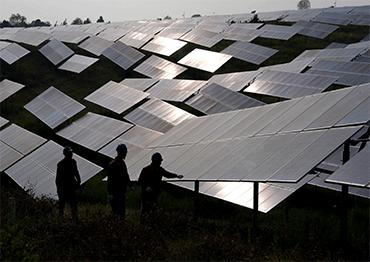
Workers check solar panels at a solar farm with an installed capacity of 90 MW, Rizhao, Shandong Province, May 22, 2024 (Photo by VCG)
“ Since I started working in the [solar] industry, the price of solar cell modules dropped steeply from 80 yuan (US$11) per watt in the early 2000s to 3.5 yuan (US$0.48) per watt today. Solar power already costs much less than thermal power,” said Shen Qiang, plant manager for Huamei Photoelectric New Material Company, a small photovoltaic (PV) glass producer in Changzhou, East China’s Jiangsu Province.
Furthermore, efficiency has increased from around 240 watts per solar module a decade ago to an average of 600-700 watts. Since China’s central and local governments stopped providing subsidies to the solar industry in the last five years, competition among manufacturers has become particularly fierce.
This deflated price and sharply increased power generation capacity will lead to companies decommissioning low-efficiency panels before their expiry dates and replacing them with better products, Shen told NewsChina.
The productive lifespan of a solar panel is 25 to 30 years. Solar modules can normally retain up to 85 percent efficiency when converting sunlight to electricity until they are decommissioned. The immediate question for the country’s solar industry is how to recycle huge amounts of solar panels when they have reached their end of life.
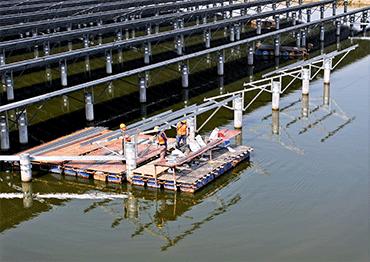
A solar farm with an installed capacity of 276 MW is set up over a fishing pond, Lianyungang, Jiangsu Province, June 3, 2024 (Photo by VCG)
Powerhouse Sector
According to statistics from the International Renewable Energy Agency (IRENA), by 2030, there will be a cumulative 8 million tons of waste PV modules globally, but this will soar to a cumulative 60-78 million tons by 2050. More than 80 percent will be crystalline silicon PV modules. China leads the world in PV modules both in output and installed capacity. Domestically, the China Photovoltaic Society projects there will be more than 1.5 million tons of decommissioned PV modules by 2030 and up to over 20 million tons by 2050.
After China pledged at the 75th UN General Conference in September 2020 that the country will achieve peak carbon dioxide emissions by 2030 and carbon neutrality before 2060, the domestic solar PV industry went into overdrive.
Local governments and enterprises commenced a green transition, with solar energy at the forefront of the development, which included solar energy stations and equipping buildings with solar panels. In 2023, China added 217 gigawatts (GW) of solar capacity, more than double its previous record of 87GW in 2022 and exceeding the total amount installed in any other nation.
According to the Research Report on Achieving Carbon Neutralization before 2060 released by Beijing-based NGO Global Energy Interconnection Development and Cooperation Organization (GEIDCO), China’s installed PV capacity will reach 1.1 billion kilowatts by 2035 and retired PV capacity will reach 110 million kW per year, corresponding to about 1.05 million tons of scrapped PV modules.
In October 2021, the Action Plan for Carbon Dioxide Peaking Before 2030 issued by the State Council said it is necessary to promote the recycling of waste from emerging industries such as decommissioned electric vehicle (EV) power batteries, PV modules and wind turbine blades.
China’s advocacy and continued efforts toward a low-carbon and circular economy have accelerated the issuance of guidelines for the solar cell recycling industry. In August 2023, six ministries collaborated on the Guidelines on Promoting the Recycling of Decommissioned Wind Power and Photovoltaic Equipment, which encourages recycling enterprises to make and adopt technological breakthroughs in resource recycling and carry out fine dissembling of retired wind turbines and photovoltaic equipment.
This guideline, for the first time, categorized solar cells as “industrial solid waste” rather than “industrial by-products.” Thus, it is no longer legal to dispose of solar equipment in landfills, nor is it allowed to put industrial solid waste into household garbage facilities. When these panels were dumped in landfill, valuable resources went to waste, and other toxic materials they contained, such as lead, could leach out.
“PV modules contain glass, aluminum, silver and more, so there’s a significant value in recycling them,” said Peng Yingdeng, a researcher at the National Urban Environmental Pollution Control Technology Research Center. But he added that PV waste sees low levels of recycling, and only a small fraction of solar panels is recycled. “Although some domestic firms recycle PV modules, most of them just employ simple dismantling measures and use the recycled materials such as frames and junction boxes as construction materials,” Professor Xia Mingxu of Shanghai Jiao Tong University told Science and Technology Daily in July 2023. The lack of government policies, mature treatment technologies, proper infrastructure and a complete recycling mechanism makes solar panel recycling expensive.
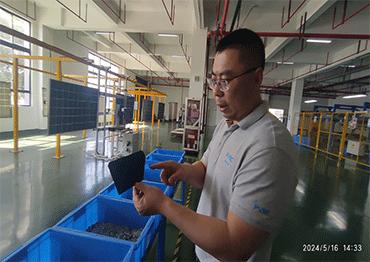
Xu Zhongxing, head of Changzhou Ruisai Environmental Protection Technology Company (PVRC) shows recycled circuit boards, May 16, 2024
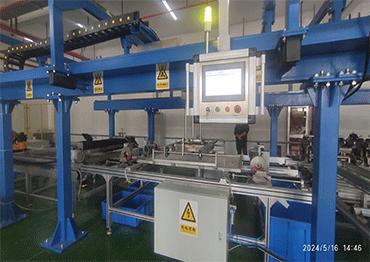
An automatic machine for dismantling frames from scrapped solar panels at PVRC, May 16, 2024 (Photos by Wang Yan)
Barriers and Endeavors
A typical crystalline silicon solar panel consists of an Al alloy frame, ethylene vinyl acetate (EVA) encapsulant, crystalline silicon chips, silver, glass and aluminum coating film. PV modules must be disassembled to remove the glass and metal components in the frames and junction boxes in the recycling process. The removal of the frame, junction box, back sheet, EVA and glass from the panel is easy and affordable by using machinery or furnaces that reach temperatures of more than 400 Celsius. But the rest of the module, which includes silicon cells coated in a silver electrode sand and contains tin and lead soldering, is rarely recycled due to cost concerns.
In China, there is no guideline for the full recovery of large-scale recycling of crystalline silicon solar panels. “As far as I know, most of the world doesn’t know how to deal with the rest of the module. The difficulty lies in the separation of metal elements from the silicon chips which is economically challenging,” Wang Xiaoliang, CEO of Changzhou Chenguang New Materials Science Company, told NewsChina. From the cost angle, Wang added that now the best way is key component recycling, which means recycling about 90 percent of the module, including the frame, plastics, cables and glass.
These technical barriers hinder largescale solar panel recycling initiatives. According to Wang, the most likely scenario is mass recovery of PV panels, not recycling, which refers to a process that crushes PV sandwiches and reuses the contaminated materials in low-value applications. Modules are largely downcycled into low-value products in construction, such as impure crushed glass particles replacing up to 30 percent of the natural sand used in mortar.
There is currently no rule for recycling companies to follow for the dismantling process, including managing the mixture of decommissioned PV modules in smelting and controlling emissions.
It has led to a disorganized and unregulated recycling industry for scrapped PV panels. Last December, China Central Television news program Topics in Focus exposed that many individual dealers in a small village in China’s central Henan Province had collected and then burned PV modules in an open-air incinerator. The pungent black fumes and residue from unregulated treatment processes had caused severe pollution and potential toxic waste issues, the program reported.
In the last decade, State-owned enterprises (SOEs) built large numbers of solar energy farms, but neither the SOEs or government agencies introduced policies for treating PV waste. Many experts have called to introduce the Extended Producer Responsibility (EPR) mechanism, which would assign producers the responsibility for dealing with end of life of products. Such a mechanism already applies to manufacturers of home appliances and EV batteries in China.
“The reason why so few companies are involved in PV module recycling is because of the lack of mature technology for the dissembling process,” Yuan Zhiwu, financial director of Ningxia Yineng Solid Waste Resources Development Company, told Science and Technology Daily in July 2023. NewsChina approached many of the country’s leading solar companies, and most have yet to put in place recycling operations for PV panels.
But there has been significant progress in PV waste recycling methods. Major recycling methods for panels include mechanical, furnaces, organic solvents, inorganic acid and alkali dissolution, and a combination of physical and chemical dismantling.
At the end of 2021, a demonstration project to research crystalline silicon PV module recycling conducted by the Yellow River Upstream Hydropower Development Company under the State Power Investment Corporation (SPIC) gained official approval from government-sponsored experts. This project indicated the setup of China’s first PV module recycling demonstration line and a closed-loop integrated photovoltaic industry chain.
In early 2023, Yingli Solar, one of China’s earliest PV companies, established China’s first demonstration project to recycle PV modules at the Solar Industrial Park in Li County, Hebei Province. This pilot recycling plant has a planned annual processing capacity of 13MW, and can attain a high-percentage, highquality recovery of glass, aluminum, silicon, silver, copper and polymer components, Yingli Solar told NewsChina. It can recycle up to 96 percent of silicon, 93 percent of silver, 97 percent of copper and 100 percent of glass and aluminum.
Private enterprises focusing on PV module recycling have emerged, such as Changzhou Ruisai Environmental Protection Technology Company (PVRC) in Jiangsu Province. In cooperation with universities and research institutes, the company has successfully developed a complete set of disassembly equipment with advanced extraction technology. According to Xu Zhongxing, chairperson of PVRC, the company has a small physical treatment demonstration recycling production line with annual capacity of up to 3,000 tons in Changzhou and another 20,000-ton capacity thermal treatment recycling line in Zhenjiang, both in Jiangsu Province. At the Changzhou project, Xu showed the reporter the automated material sorting processes and some fully recovered final products.
“Our team developed all the automated equipment and we hold the proprietary patents. The core technologies allow high recycling yields in selective delamination, automated material sorting, silver extraction from solar cells and tin extraction from strips,” Xu told NewsChina. The company has successfully attained up to 95 percent recapture.
Preparations and Partnerships
Although there is yet to be an enormous influx of decommissioned PV panels, enterprises have begun to map out plans and secure possible partnerships with key power stations.
“Since our company was established in 2018, we’ve established a lot of relationships with leading solar companies. The total amount of PV waste last year in China was about 40,000 to 50,000 tons. Our company got around 20,000 tons, almost half, but most of the rest was in the hands of backyard dealers,” Xu from PVRC said. These figures include PV panels that were obsolete and decommissioned early due to efficiency concerns, as well as trial products directly from factories.
Xu said that he expects the government to release a list of approved PV module recycling companies. After this, upstream solar companies or power stations would designate their preferred recycling partners so they met official standards. The list would also restrict unregulated operations by small dealers operating out of backyards.
“The main difficulty stems from the disorderly rush to get hold of enough PV waste. This causes profit margins to be small or even nonexistent, which certainly discourages regular enterprises from engaging in PV waste recycling,” Xu said. Therefore, even leading PV manufacturing enterprises and top players in the electric power industry refuse to make huge R&D investments in the sector.
For PVRC, previously established business ties with upstream companies allowed them to get 20,000 tons of PV waste in 2023, which could generate about 15 percent gross margin profit, the percentage of revenue that exceeds production costs. With sound management and advanced technology, Xu believes a new project with the capacity to recycle up to 200,000 tons to be constructed in Suqian, Jiangsu Province, would definitely be a future money spinner.
In the opinion of some industry insiders, government subsidies are the only way to stimulate the industry and encourage new players. A spokesperson from Yingli Solar compared it to the subsidies in the early days of the solar industry. “In the long term, to build a circular market we need comprehensive measures, including support from [government] policy, technology, economy and society,” the spokesperson told NewsChina. Xu, however, said he is not expecting government subsidies. “There are no subsidies for EV battery recycling in China either, and right from the start, we believed our technological superiority, combined with a considerable amount of PV waste, our already attained highvalue and integrated recycling system, would make us profitable in a sustainable way,” he said.
PVRC has begun seeking potential deals with power stations including those operated by SPIC and the China Three Gorges Cooperation, as some of their solar projects are approaching decommissioning deadlines. As the State has already issued some technical reform requirements for large ground power stations, detailed policies and related decommissioning procedures are expected no later than the end of 2025.
“We’ve been involved in some small solar power decommissioning programs in Inner Mongolia Autonomous Region, and we’re expecting more opportunities to come when large-scale solar decommission programs are launched,” Xu said. “As we have kept very good ties with those key power stations. So once the market is open, I believe that PVRC will enjoy more advantages at an earlier stage than others.”
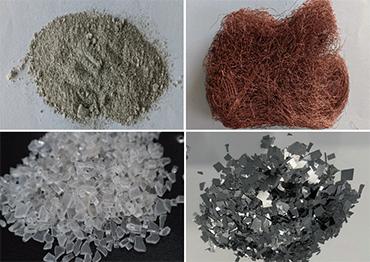
Clockwise from top left: The final products from recycled solar panels – silver powder, copper wires, silicon and glass (Photos by Wang Yan)
Dawning Time
Provincial and city governments have provided support for solar panel recycling companies under China’s stewardship program for the circular economy. Xu said that in Jiangsu, support includes favorable policies to buy land for plants, tax exemptions or reductions and offering special environmental protection loans.
All experts interviewed emphasized that solar panel recycling will become an essential sector in the value chain of the PV industry. “I believe the solar panel recycling industry requires time to develop, both for the development of technology and for the finalization of policies and mechanisms,” materials expert Wang Xiaoliang said. “In an ideal world, we would evolve from mass recovery to value recovery and full recovery, which means plastic back to plastic, metals to metals, glass to glass, so there is still potential for R&D and technical progress,” Wang added.
“PV module recycling is a sunrise industry, and now it’s approaching the dawn. It has to go through the darkest moment before the sunrise. If such private enterprises in the recycling sector can survive and continue operations for, say, three to five more years when the technologies get more developed, they will stand out and win,” PV manufacturer Shen Qiang said. Companies like Ruisai that started earlier will be able to accumulate experience and establish their reputation, stealing a march on the latecomers.
As more capital flows into the industry, more R&D professionals will rush in to innovate technology to reshape the industrial system and improve the modernization level of the industrial system.
Xu is confident. “The market is sure to boom in the near future.”

 Old Version
Old Version




